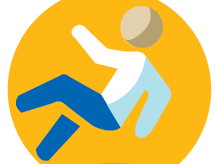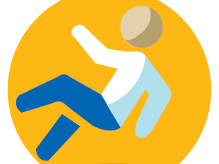 The WSJ article circles the problem. When 41,000 older adults die as a result of falls each year at a cost of $80 billion (projected to $101 billion by 2030), maybe more scrutiny is required than this (unlocked) WSJ article provided. Each year 1 in 4 older adults fall, and the number of (reported) falls is rising each year. Note that 43% of women aged 75 live alone – hazards in the home can increase the risk of falls. A person living alone is at risk of an undetected fall and, as with Jane Glenn Haus, an associated long lie time. According to the CDC, “falls account for 25% of all hospital admissions and 40% of all nursing home admissions. 40% of those admitted do not return to independent living; 25% die within a year.”
The WSJ article circles the problem. When 41,000 older adults die as a result of falls each year at a cost of $80 billion (projected to $101 billion by 2030), maybe more scrutiny is required than this (unlocked) WSJ article provided. Each year 1 in 4 older adults fall, and the number of (reported) falls is rising each year. Note that 43% of women aged 75 live alone – hazards in the home can increase the risk of falls. A person living alone is at risk of an undetected fall and, as with Jane Glenn Haus, an associated long lie time. According to the CDC, “falls account for 25% of all hospital admissions and 40% of all nursing home admissions. 40% of those admitted do not return to independent living; 25% die within a year.”
The reasons for falls are varied, but some trends are revealing. Prescription drug use is on the rise, with at least 85% of adults aged 60+ taking them. Are they taking them as prescribed? Not necessarily, according to one study – sometimes to save costs. And no surprise, certain common medications increase fall risk. Other factors contribute to fall risk, according to the WSJ article, such as distraction, lack of exercise, and ill-fitting shoes. Consider distraction – you see it everywhere –people walking, talking and looking at a device rather than watching their feet. Does this stop when they pass the age of 65? Hardly.
Exercise to mitigate fall risk? Interestingly, states with the lowest level of physical activity among older adults also had the highest rates of falls. Efforts to get sedentary older adults up and moving do not seem to be working particularly well, especially in those states. However, there are lists of exercises to reduce risk – it’s particularly useful to increase strength and improve balance.
Considering that a person may fall more than once, detection matters. A news site recently ran a story about the failure of fall detection tech in a memory care facility. Many things were unfortunate in that story – the facility’s lack of oversight of the technology worn by a person with dementia, even after repeated falls. It’s not the first time, though, that fall detection failed to detect and the wearer died – making the news back in 2014, eventually driving Philips out of the Lifeline business. Still, is some likelihood of detection better than none? Consider the falls inside the home of a person who cannot get up unassisted.
Fall detection – and even prevention – technology vendors continue to innovate. Consider Inspiren’s AUGi to monitor safety in senior living – with the intent to prevent falls before they happen. WiFi fall detection (without a wearable) has been researched and is in-market today. Environment-based fall detection with heat sensing is in-market today. And Apple Watch wearers can have fall detection linked to a call monitoring center. The depressing examples of device failures should motivate tech firms. They need to offer more useful tech, including in-home sensing and cool-looking wearables that don’t make a person feel old. And most important, when a customer buys, the sellers should do regular check-ins to make sure the device is being appropriately charged, working and is being used correctly. As the links in this post show, improper use or failed devices leave a black mark on the industry.
